
Vicia hirsuta is a species of flowering plant in the pea and bean family Fabaceae.

Allium crispum is a species of wild onion known by the common name crinkled onion. It is endemic to California, where it grows along the Central Coast in the Coast Ranges and in the Santa Monica Mountains, often in clays and serpentine soils. It is a perennial herb that is typically found in the foothill woodlands and valley grasslands of California.
Eryngium castrense is a species of flowering plant in the family Apiaceae known by the common name Great Valley eryngo, or Great Valley button celery. This plant is endemic to California, where it grows in wet areas such as vernal pools and ponds in the central part of the state. This is a heavily branched, spiny perennial herb reaching maximum heights of around half a meter. It produces light green to grayish green hairless stems with occasional lobed, oval-shaped leaves. At the tops of the stems are flower heads one to one and a half centimeters wide and rounded or egg-shaped. At the base of each head is an array of 7 to 9 spiny, pointed bracts up to three centimeters long, and sometimes a few smaller bractlets above. The rounded flower head contains many small white to light purple flowers.

Erysimum ammophilum is a species of wallflower known by the common name coast wallflower.
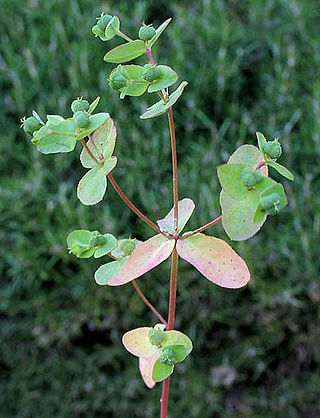
Euphorbia spathulata is a species of spurge known by the common names warty spurge and roughpod spurge.

Lepidium nitidum, known by the common name shining pepperweed, is a species of flowering plant in the mustard family.

Solidago nemoralis is a species of flowering plant in the family Asteraceae. It is native to North America, where it is widely found in Canada and the United States. Its common names include gray goldenrod, gray-stem goldenrod, old-field goldenrod, field goldenrod, prairie goldenrod, dwarf goldenrod, and dyersweed goldenrod.

Mesembryanthemum nodiflorum is a species of succulent plant in the genus Mesembryanthemum known by the common name slenderleaf iceplant. It is the type species for the genus. It is native to coastal areas of the Mediterranean Basin, Macaronesia, and Middle East but it is known in many other places as an introduced species and sometimes an invasive weed, including several regions of Australia, parts of the western United States and adjacent Mexico, and some Atlantic islands.
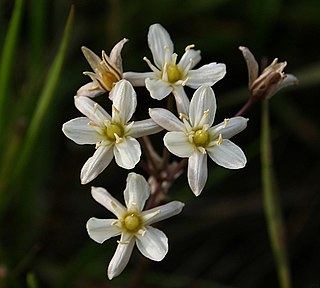
Muilla maritima is a species of flowering plant known by the common names sea muilla and common muilla. It is native to California and Baja California, where it grows in many types of habitats from the coast to the Mojave Desert and Sierra Nevada foothills and other inland mountains, in grassland, woodland, desert, and forest floras. It is a perennial plant growing from a corm and producing an erect flowering stem up to half a meter tall. The onion-like leaves at the base of the stem may be 60 centimeters long. The flowering stem bears an umbel-shaped array of many flowers on pedicels up to 5 centimeters long. Each flower has six tepals which are green-tinged white in color with brownish midribs and no more than 6 millimeters in length. At the center of the flower are six erect stamens with blue, green, or purplish anthers.
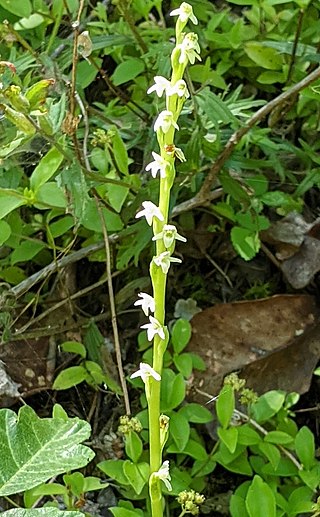
Platanthera ephemerantha is a species of orchid known by the common names whiteflower rein orchid, slender white piperia, and white-flowered piperia. It is native to western North America from Alaska to the San Francisco Bay Area, where it grows in coniferous forests and other habitat in coastal and inland mountain ranges within 150 kilometers of the coast. It grows erect to about half a meter in maximum height from a bulbous caudex. The basal leaves are up to 18 centimeters long by 3 wide. Leaves higher on the stem are much reduced. The upper part of the stem is a spikelike inflorescence of up to 100 small flowers, mostly arranged along one side of the stem. The fragrant, honey-scented flowers are whiter than those of other Platanthera, but sometimes green-tinged or -veined, or green with white margins. The status of this species in the wild is difficult to determine because most populations are small and may produce flowers only rarely.

Pyrrocoma carthamoides is a species of flowering plant in the family Asteraceae known by the common name largeflower goldenweed. It is native to western North America from British Columbia to northeastern California to Wyoming, where it is known from grassland, woodlands, forests, barren areas, and other habitat. It is a perennial herb growing from a taproot and producing one or more stems to about half a meter in maximum length, the stems reddish-green and leafy. The largest leaves are at the base of the stem, measuring up to 20 centimeters long, lance-shaped with spiny sawtoothed edges. Leaves higher on the stem are smaller and hairier. The inflorescence is a single flower head or a cluster of up to four. Each bell-shaped head is lined with phyllaries each up to 2 centimeters long. It has many yellow disc florets surrounded by a fringe of yellow ray florets up to 7 millimeters long; ray florets are occasionally absent. The fruit is an achene which may be well over a centimeter in length including its pappus.

Pyrrocoma lanceolata is a species of flowering plant in the family Asteraceae known by the common name lanceleaf goldenweed. It is native to western North America from central Canada to northeastern California to Colorado, where it grows in many types of habitat, including disturbed places and areas with wet, alkali soils. It is a widespread and variable plant. It is a perennial herb growing one or more stems up to about half a meter long. The stems are decumbent or upright, reddish, usually somewhat hairy to quite woolly, and glandular toward the ends of the stems. The largest leaves are at the base of the plant, each measuring up to 30 centimeters in maximum length. They are generally lance-shaped with sawtoothed edges. The inflorescence bears several, up to 50, flower heads lined with reddish to green phyllaries. Each contains yellow disc florets and ray florets. The fruit is an achene up to a centimeter long including its pappus.
Sagina decumbens is a species of flowering plant in the family Caryophyllaceae known by the common names trailing pearlwort and western pearlwort. It is native to several areas of North America, where it can be found in many types of habitat. It is a small annual herb producing a threadlike green or purplish stem growing erect or trailing, measuring up to about 16 centimeters long. The leaves are hairless, linear in shape, and one half to two centimeters long. The inflorescence is a solitary flower borne on a threadlike pedicel. The flower has usually five sepals and five tiny white petals. There are two subspecies which differ mainly in the microscopic appearance of the seeds.
Sedum radiatum is a species of flowering plant in the family Crassulaceae known by the common name Coast Range stonecrop. It is native to Oregon and California, where it is known from several coastal and inland mountain ranges, including the Klamath Mountains and the Sierra Nevada. It grows in many types of rocky habitat, sometimes on serpentine soils. It is an annual or biennial succulent plant producing several stems with elevated, somewhat basal rosettes of leaves. The leaves are not much more than a centimeter long. They are green or yellowish with green, purple or red veining. The inflorescence is a short, erect array of many densely packed flowers. The flowers have yellow, cream, or white petals which are lance-shaped and one half to 1 centimeter long.

Packera bolanderi is a species of flowering plant in the aster family known by the common names Bolander's ragwort and seacoast ragwort. It is native to the west coast of the United States from Washington to northern California, where it grows in wet coastal forests and woodlands. There are two varieties of the species which differ slightly in morphology and habitat occupied; these varieties have been considered separate species by some authors. The var. bolanderi has thicker leaves, occurs farther south, and occupies more open types of habitat, than does var. harfordii. This plant in general is a perennial herb producing one to three stems up to half a meter tall. The basal leaves have blades up to 12 centimeters long which are divided into several lobes and borne on long, thin petioles. Leaves growing farther up the stem are smaller and have more lobes on their blades. The inflorescence contains several flower heads, each lined with dark green phyllaries. The head contains many golden yellow disc florets and generally either 8 or 13 yellow ray florets each over a centimeter long. The fruit is an achene tipped with a pappus of bristles.
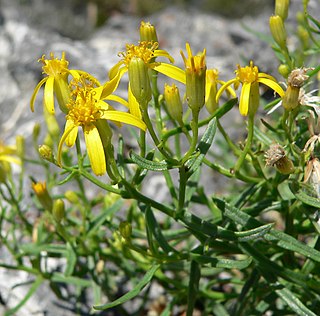
Senecio spartioides is a species of flowering plant in the aster family known by the common name broom-like ragwort. It is native to the western United States as far east as the Dakotas and Texas, and northern Mexico. It can be found in dry, rocky, often disturbed areas in a number of habitat types. It is a subshrub which can exceed a meter in height, its arching stems growing from a woody-topped taproot. The leaves are linear in shape and up to 10 centimeters long. The leaves usually have smooth, unlobed edges, but slightly lobed leaves are seen at times. The leaves are evenly distributed along the stems, the ones low on the stems withering away early, giving the plant a naked appearance on the lower half while the top is still lush green and blooming. The inflorescences are spreading, flat-topped arrays of many cylindrical flower heads. The heads contain yellow disc florets and generally either 5 or 8 ray florets each about a centimeter long.
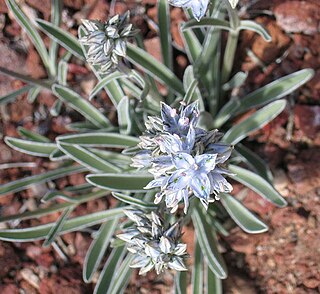
Frasera albicaulis is a species of flowering plant in the gentian family known by the common name whitestem frasera. It is native to the northwestern United States, where it grows in open areas in mountain habitat. It is a perennial herb growing from a woody base surrounded by rosettes of leaves, its stem growing 10 to 70 centimeters tall. The leaves are green with white margins. The basal leaves are lance-shaped, up to 30 centimeters long, and borne on petioles. Leaves higher on the stem are smaller and narrower and are oppositely arranged. The inflorescence is a dense panicle atop the stem, sometimes interrupted into a series of clusters of flowers. Each flower has a calyx of four pointed sepals and a corolla of four pointed lobes each one half to one centimeter long. The corolla is pale greenish white to light blue to purple, often dotted, streaked, or veined with darker blue. There are four stamens tipped with large anthers and a central ovary.
Frasera neglecta is a species of flowering plant in the gentian family known by the common name pine green gentian.

Trianthema portulacastrum is a species of flowering plant in the ice plant family known by the common names desert horsepurslane, black pigweed, and giant pigweed. It is native to areas of several continents, including Africa and North and South America, and present as an introduced species in many other areas. It grows in a wide variety of habitat types and it can easily take hold in disturbed areas and cultivated land as a weed.

Tricardia is a monotypic genus of flowering plants in the borage family containing the single species Tricardia watsonii, which is known by the common name threehearts. It is native to the southwestern United States, where it grows in deserts and mountains in sandy open habitat, often beneath shrubs. It is a perennial herb growing from a taproot and a woody caudex covered with the shreddy remains of previous seasons' herbage. It produces several erect stems up to about 40 centimeters tall. Most of the leaves are located in a basal rosette about the caudex. They are lance-shaped and coated thinly in woolly hairs. They are up to 9 centimeters long and are borne on petioles. A few smaller leaves occur higher on the stem. Flowers occur in a loose cyme at the top of the stem. Each has a calyx of five sepals. The outer three are heart-shaped and green to pink or purple in color, and the inner two are much smaller and narrower. The flower within is bell-shaped, white with central purple markings, and roughly half a centimeter wide. The fruit is a capsule just under a centimeter long which contains 4 to 8 seeds.
















